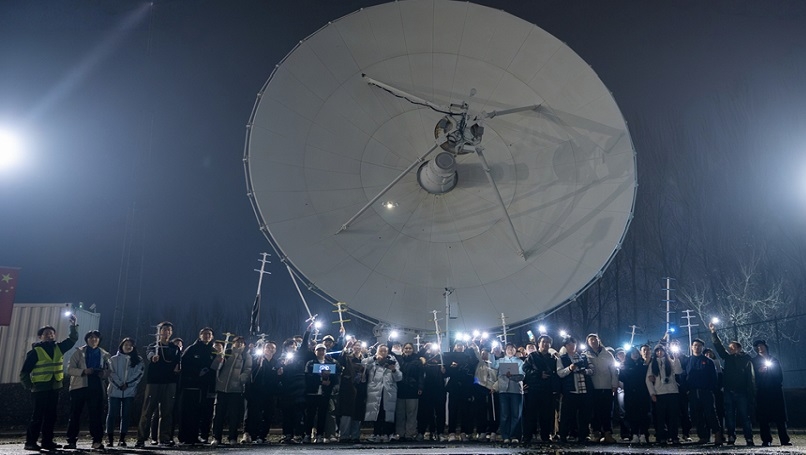Three-Body Universe recently partnered with amateur radio stations at Chinese universities to transmit fan-submitted images worldwide in commemoration of its annual "Three-Body Day" celebration on Oct. 21.

Participants pose for a photo during a signal reception event at Harbin Institute of Technology in Harbin, Heilongjiang province, Nov. 1, 2025. [Photo courtesy of Three-Body Universe]
Three-Body Universe, the global exclusive rights holder of the "Three-Body" intellectual property, collaborated with amateur radio stations at Tsinghua University (BY1QH), Beijing University of Posts and Telecommunications (BY1BY) and Harbin Institute of Technology's ASRTU Friendship MicroSat (ASRTU-1) for the "Three-Body Day - Civilization Signal Collection" campaign, which ran through Nov. 2.
Fifteen creative submissions from the public, representing diverse perspectives on humanity's future and cosmic civilization, were transmitted globally via radio from the three universities.
The signals, receivable as images via slow-scan television (SSTV) and digital slow-scan television (SSDV) technology, reached thousands of "Three-Body" fans and radio enthusiasts across more than 10 countries on four continents.
Three-Body Universe co-founded Three-Body Day with Liu Cixin, author of the Hugo Award-winning science fiction novel "The Three-Body Problem," which inspired the global franchise. The festival brings together franchise filmmakers and television producers, universities, industry organizations and global fans through online and in-person activities.
The radio event posed fundamental questions drawn from a pivotal moment in the novel when humanity receives and replies to a signal from the Trisolaran civilization: Should we respond to extraterrestrial contact? And if so, what message should we send?
SSTV and SSDV formats, both classic amateur radio and aerospace transmission methods, were used to transmit the submissions.
Adopting this approach not only "created a poetic dialogue between technology and humanities but also represents an innovative fusion of cutting-edge aerospace technology and human imagination," Three-Body Universe said in a statement.

Students attend a lecture on the slow-scan television (SSTV) format at Beijing University of Posts and Telecommunications in Beijing, Nov. 1, 2025. [Photo courtesy of Three-Body Universe]
As a key component of this year's Three-Body Day, the radio campaign encouraged public engagement with aerospace technology and radio knowledge through combined shortwave and satellite radio transmissions.
Organizers said the activity not only stimulated public curiosity about science and technology but also effectively implemented science education through hands-on offline experiences.
As part of the campaign, universities hosted practical activities including signal reception sessions and science lectures. Students at the Beijing University of Posts and Telecommunications learned about SSTV principles, while participants from the Harbin Institute of Technology operated equipment to receive space signals. The campaign also connected sci-fi enthusiasts with radio experts, enabling interdisciplinary exchanges.
Author Liu Cixin also transmitted a message to the stars along with the signals: "Let us maintain our interest in science fiction, our curiosity about the unknown, and our love for life."
Three-Body Universe stated that it will continue to provide global fans with innovative experiences while also building bridges between the public and technology to inspire young people's interest in human civilization and the future.


 Share:
Share: 




 京公網安備 11010802027341號
京公網安備 11010802027341號